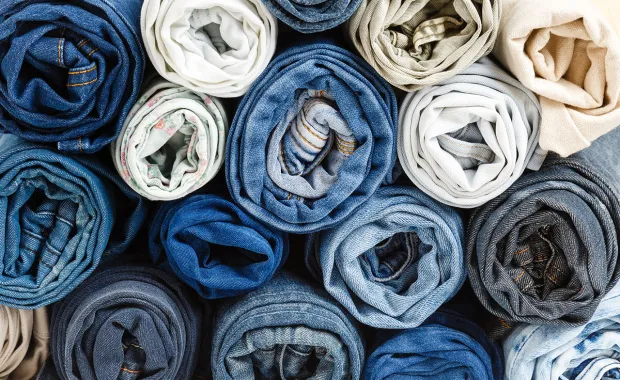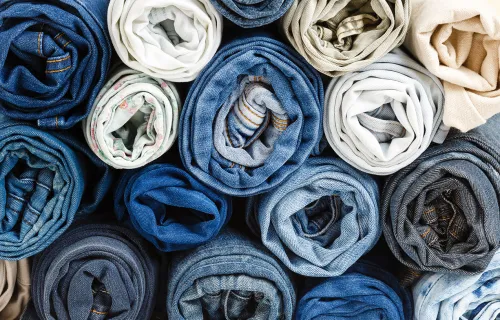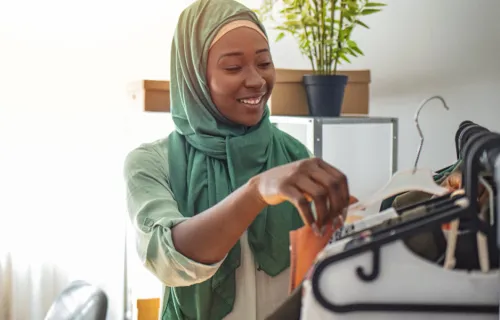In 2020, for the first time ever, all the weight of things made by people (such as cement, glass, plastic and textiles) was higher that all the biomass globally (such as plants, animals, bacteria and people) [1]. Undeniably, all these people-made materials have helped build the fundaments that support our societies and life-styles today.
We can’t imagine most of our daily lives without clothing. About 170.000 years ago we started to walk around wrapped in a fashionable combination of fur, leather, leaves and grass, mostly to protect our bodies from the elements. This innovation allowed humans to migrate beyond Africa and expand their horizons [2]. Our clothing then was made with unprocessed materials that could be safely returned to the soil.
Nowadays our clothes not only offer comfort and protection, but are part of our status, culture, identity and lifestyle. We use them as motivators to stick to our morning run, or as boosters of our confidence and self-esteem. We use special attires to sleep, to mourn, to get married, and to signal that we belong to a certain group. Against many Hollywood clichés, clothing has overcome its perceived superficiality and gained a depth that helps define society.
However, now our clothing industry is in need of a turning point. This blog is focused on more of the why, the impact of eco-design regulation and outlines four practical perspectives rethinking the way we make, use, sell and reuse clothing.
Why do we need a turning point in the clothing industry?
The majority of our clothing is currently composed by a mix of technical and biological elements that are difficult to separate for reuse at their highest value. Take your favorite pair of jeans. They’re probably made from a mix of cotton and elastane, a label made from polyester, finished with buttons or zips made from metal. On average in the Netherlands we have 170 items of clothing, wearing a piece only seven times, while we buy 46 new items every year and throw away 40 [3].
Visiting my family in Colombia every once in a while I have been fly-shamed by some friends, but never received any such comments regarding my wardrobe. Yet, the clothing industry emits as much CO2 as aviation and shipping combined [4]. Every year, 35 million tons of clothes end up in incinerators and landfills [5]. In the Netherlands alone, this number reaches 145 million kilogram annualy [6].
Although recycling and reuse of clothing has been steadily gaining attention, still less than half of all used clothes are collected for reuse or recycling and only 1% is recycled [7]. Growth in fast and ultra-fast fashion has been hindering these processes as the quality of materials is so low that it could easily fall into the category of single-use products.
Impact of new EU eco-design regulation
As the Dutch government aims to have a circular economy by 2050 new legislation is coming into effect in the coming years. This is to help stimulate for the entire value chain to adopt technical and social innovations that allow for durability, reliability, repairability, upgradeability, reuse, repurposing, and recycling. Already in 2023 the extended producer responsibility law is starting to be enforced which makes manufacturers, producers and retailers responsible of collection, sorting and treatment of end-of-life of textiles.
Currently proposed EU eco-design regulation sets requirements for all products regarding circularity. This covers resource use and efficiency, including use of secondary materials, presence of hazardous chemicals, environmental impacts, and expected generation of waste materials. A digital passport for clothing will become mandatory, providing information on harmful chemicals, repairability, and fiber composition. Businesses would also be required to make information public on the destruction of unsold products, facilitating the banning of such practices [7].
Regulatory impact fueled with changing consumer demands will give the industry an extra boost in becoming circular, with focus on high quality and more durable clothing that stays longer in the loop. Fortunately, some retailers are already well aware of this and take steps to rethink their businesses delivering better outcomes for their ecosystem partners, clients and the environment. This is also part of wider focus on sustainability CGI sees addressed in annual clients interviews as part of CGI’s Voice of Our Clients program. Importance of environmental sustainability in creating future value for stakeholders is growing rapidly.
If you are a retailer, manufacturer or producer looking for inspiration on how to accelerate the change I have four practical ways to adopt your business model. To help you look forward and rethink the way we make, use, sell and keep clothes in the loop.
Four ways to rethink the way we make, use, sell and reuse clothing
- Smart and digital clothing
-
Using smart technology available today, we could instantly personalize garments according to consumers' wishes, for example by changing colors or sizes, thereby reducing the need to produce multiple versions of the same clothing item. Some examples are children’s’ pants that expand as they grow, or clothes with smart textiles that allow for changing color and patterns. 3D printing is fueling production on demand, locally and at point of sale and allows consumers to personalize their items and get emotionally attached to them. This also avoids overproduction and waste of materials and even make room for manufacturing practices in EU [7].
- Clothing as a service
-
Renting, leasing, swapping, sharing and restoring clothing as needed reduces the need to make new clothing increasing the number of wears of an item. Subscription models for example are already well established in high fashion, especially for accessories, although everyday clothes are increasingly entering this market.
Clothes libraries with subscription models already exist borrowing clothing in a book-like fashion. Informal practices such as swapping and sharing are being widely used for baby and maternity clothes. Clothing as a service can be combined with traditional business models, but requires innovations in logistics, quality control, maintenance, repairability, take-back schemes and reversed logistics [7, 8]. A big enabler would be designing clothes with high quality materials that extend their lifetime.
As a foundation, the creation of data-sharing platforms, for consumers, producers and manufacturers, will help increase the availability of information on material contents, product use and instructions on repair or reuse. This would allow for a better material efficiency and durability and even create new value streams, such as repair and maintenance services.
- Collection and resale
-
The resale market for clothing is expected to grow three times as fast as the market for new clothes, in the next 5 years [9]. Reselling used clothes extends their useful life, replaces new purchases and reduces the amount of used clothing that end up in landfills, mostly in the poorest countries. Retailers can arrange take-back schemes to collect their own products, repair them or update them, and sell them again. The current platformization of the clothing industry could give an extra boost to the sale of pre-loved clothing, unburdening both sellers and buyers from the most tedious tasks of these processes and increasing the trust of the deals.
- Reusing and repurposing materials
-
Textiles and other materials of used clothing could be turned into new items. Likewise, materials from other industries that would otherwise be thrown away can also be used. Existing examples are shirts and jackets made from old jeans, shoes and bags made from old car tires, jackets and accessories made from billboard vinyl and handbags made from plastic bags.
Reusing and repurposing requires in the first place that materials are of good quality. Further innovations are needed in design, use of sustainable materials and dis-assembly to facilitate recyclability, but also collaborations and partnerships with other industries could result in an interesting availability of materials to be repurposed in fashion.
We will need to look at clothing again as valuable items to be cherished. We need ecosystems supporting the entire value chain that allows for reusability, recyclability, durability and innovative collaborations, and we need leadership with companies willing to step up and set the pace of this transition and ongoing transformation. Are you in? Feel free to contact me and together we’ll discover a world of opportunities making the next steps.
Sources
- Elhacham, E., Ben-Uri, L., Grozovski, J. et al. Global human-made mass exceeds all living biomass. Nature 588, 442–444 (2020)
- UF study of lice DNA shows humans first wore clothes 170,000 years ago
- Hoeveel kleren gooi jij ieder jaar weg?
- The price of fast fashion
- A New Textiles Economy: Redesigning Fashion's Future
- Jaarlijks belandt 145 miljoen kilo kleding bij het restafval
- Textiles and the environment
- Luca Coscieme, Saskia Manshoven, Jeroen Gillabel, Francesca Grossi & Lars F. Mortensen (2022) A framework of circular business models for fashion and textiles: the role of business-model, technical, and social innovation, Sustainability: Science, Practice and Policy, 18:1, 451-462, DOI: 10.1080/15487733.2022.2083792
- thredUP Resale Report





